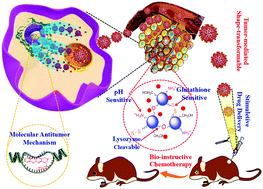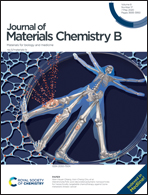Tumor-mediated shape-transformable nanogels with pH/redox/enzymatic-sensitivity for anticancer therapy†
Abstract
Lack of sufficient tumor penetration of the current nanomedicines is a major reason limiting their clinical success in cancer therapy. In this work, we aimed at the development of a novel biodegradable nanoplatform for the selective and controlled delivery of anticancer agents, with improved tumor permeability and the ability to release ultrasmall nanovesicles in the tumor microenvironment. To this end, positively charged nanogels were obtained through the double-crosslinking of chitosan with an ionic physical gelator and a disulfide-containing chemical crosslinker. After conjugation to an anionic oligomer, the cationic nanogels were transformed into negatively charged nanocarriers (CTCP), enabling effective encapsulation of the cationic anticancer agent doxorubicin (DOX) to generate a biodegradable nanomedicine (DOX@CTCP). DOX@CTCP could maintain sustained DOX release and decreased DOX toxicity. Upon arrival at the tumor tissue, the reductive and lysozyme-high microenvironment drives the cleavage of the nanomedicine to release DOX-carrying nanoblocks of smaller size, which together with their acidic-protonable feature achieves an effective therapeutic delivery into cancer cells. The nanomedicine described here showed excellent biocompatibility/biosafety and enhanced in vivo antitumor efficacy.

- This article is part of the themed collection: Journal of Materials Chemistry B HOT Papers


 Please wait while we load your content...
Please wait while we load your content...